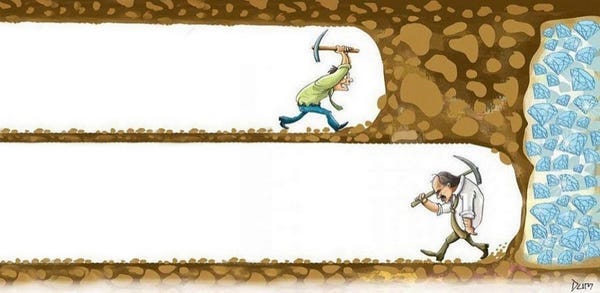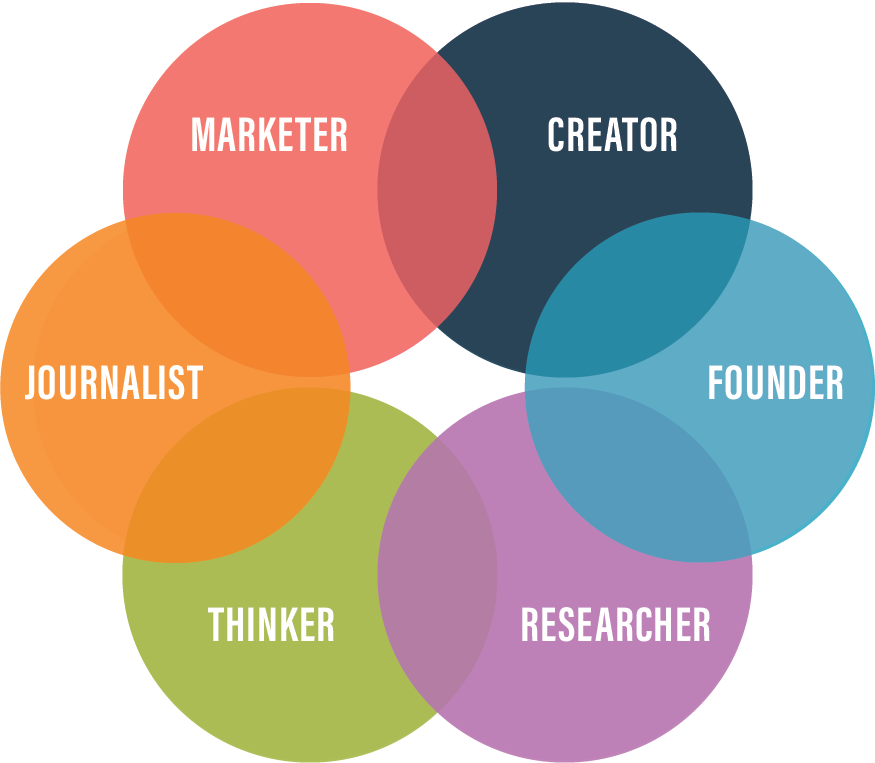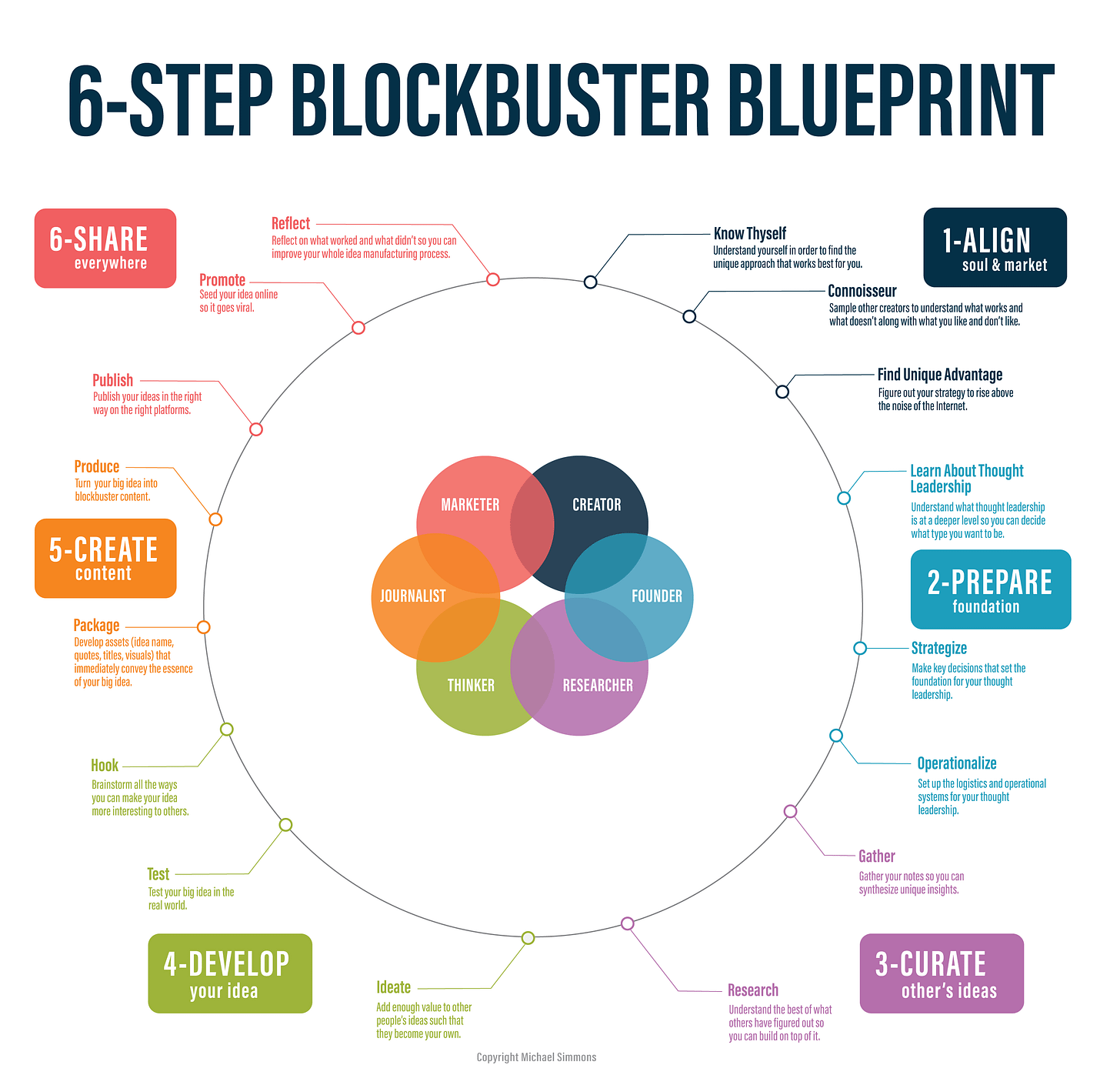Blockbuster Blueprint: The Most Comprehensive Map Of Thought Leadership (Based On Thousands Of Hours Of Development)
Personal Update: I feel proud and excited to write this post. The map I share is the culmination of thousands of hours of development that I’ve done with my own articles, with clients of the content agency I used to have, and with students in the live cohorts I teach. This is the first time I am properly introducing it to a wider audience.
You’ll see this map a lot in the coming years as I refine and expand upon it and use it to contextualize the content I share. This will help you see the connection between specific posts and the big picture.
For paid subscribers, I recorded a video walkthrough at the bottom (will be posted at 2:30pm EST today) that goes much deeper on each of the steps and stages so that you can internalize the model.
I welcome any and all feedback/questions in the comments.
The Story Of Why I Created The Map
When I was in my twenties, I wrote 250+ blog posts. Every night after work, I’d stay up one or two hours later in order to write and publish a blog entry. My logic was simple: If I publish more, I will automatically become better and get traction.
At about 18 months in, my writing had a little traction but not much. And, no matter what I wrote about, I couldn’t get off the plateau. Furthermore, I couldn’t really tell from the few comments I received whether people were actually getting value or just giving me encouragement. So, I was in no man’s land, and I didn’t know whether I should continue or stop.
One day, I read a blog post by Seth Godin that asked a fundamental question…
Seth’s words hit me like a ton of bricks, and I knew I had the answer to my dilemma. To test whether my writing mattered, I decided to end my streak to see if any of my readers cared.
If people asked me where I had gone, I knew that they at least cared a little. If there was complete radio silence, then I knew that my writing didn’t really resonate.
Not one reader ever emailed me. The conclusion was clear: My writing didn’t matter.
It was a brutal realization.
I had wasted hundreds of hours thinking I was moving toward my goal when, in actuality, I was standing still. The meaning I took away from this was, “I guess I’m not a good writer.” So, I took the next logical leap and stopped writing. If writing was not for me, why bother?
I didn’t write again for years.
When I decided to write again in 2013, I knew I needed a better approach than Publish and Pray.
First, I made a commitment to spend more time on every article in order to make it great. I write about this decision in Blockbuster: The #1 Mental Model For Writers Who Want To Create High-Quality, Viral Content.
The strategy started working immediately.
My Forbes articles had 10x the views of the average article on Forbes. And, over time, as people went back through my body of work, that number became 50x as much. Not only that, I had people writing me saying that some of my articles were the best they had ever read.
This immediate resonance gave me inspiration. I wondered, what if I keep on improving the quality of my writing?
But this time, rather than just improving my writing by spending more time on each article, I made another critical decision.
I decided to learn the skills, mindsets, workflows, mental models, paradigms, and whatever else was necessary to become a world-class thought leader. In other words, I chose to be deliberate about improvement.
Why I Chose To Spend Thousands Of Hours Mastering Thought Leadership
At a deeper level, I chose mastery for a few reasons...
#1: The bar to stand out is high and getting higher
Even back in 2013, the writing was on the wall. As more people spent more time creating content, it would require a higher and higher level of quality to stand out. Given this trend, it made sense for me to gain mastery now to prepare for this world of information overwhelm.
#2: Almost no one is deliberate about learning thought leadership
In any other discipline, people don’t expect to just show up, wing it, and be successful. Doctors don’t skip med school and jump into surgery. Computer scientists first learn how to code.
Yet, when it comes to thought leadership most people are drastically overconfident. Maybe it’s because they have been speaking and writing their whole life. Maybe it’s because publishing online is so easy.
What I saw early on is that:
Thought leadership is a real discipline like any other discipline.
If I spend years mastering that discipline, I can’t help but be successful.
Especially when most people don’t even realize there is a discipline to master.
#3: There is a timeless skillset that I could use for the rest of my life
Ever since I’ve been 16 years old I’ve been a hardcore learner. Ever since I was 18 I’ve loved sharing what I learn with others and seeing the impact. This gave me confidence that these were lifelong passions. It was hard to imagine a future in which I wasn’t learning, thinking, and sharing.
So, even if thought leadership didn’t remain my core career, I knew that I would be doing it for the rest of my life. And, if I was planning to do it forever, why not master it early so that I could spend my life reaping the rewards of my early investment?
This Learning Process Helped Me Master Thought Leadership Faster
The fight is won or lost far away from witnesses – behind the lines, in the gym, and out there on the road, long before I dance under those lights.
—Muhammad Ali
I originally thought the mastery process would take a year or two. It’s 10 years later, and I’m still a student.
Since 2013, I have spent many thousands of hours deliberately:
Identifying the highest leverage micro-skills to learn.
Identifying the topic experts throughout the world who specialize in those skills.
Studying the work of those experts and extracting patterns.
Performing thousands of tests on those patterns.
Applying the lessons to my own work and getting tens of millions of views and millions in revenue as a result.
Personally teaching the lessons to students in live cohorts and doing one-on-one coaching to help students get results.
Sequencing the skills so that they’re learned in the right order (just like addition is learned before multiplication, which is learned before algebra).
For example, when it came to learning titles:
I purchased $500/month access to proprietary data on 1+ billion article results.
I spent 1,000+ hours analyzing patterns among those titles in spreadsheets.
I A/B tested 4,000+ titles.
The investment paid off.
Over the last 10 years, I’ve gone from having no following to:
Being published in the Harvard Business Review, Forbes, Fortune, World Economic Forum, and TIME among many other publications.
Having an impact on 10M+ people with my long-form content.
Earning millions of dollars.
Many of the lessons I learned from this process I hadn’t seen written about anywhere else. In fact, I had to coin dozens of terms to explain the patterns I was noticing. So, I decided to share what I learned with others. Not only that, many of the books and articles on writing and titles were actually different than what top performers do.
But, rather than just doing one live cohort and making the curriculum on-demand, I decided to replicate the blockbuster process and keep improving things until I couldn’t improve them anymore. We’re now on the sixth cohort of our year-long program. I teach every class and help students one-on-one. I’ve now spent thousands of hours building, testing, and revising the curriculum. Stated differently, every class hour includes 25+ hours of research, development, feedback, and iteration.
At first, I didn’t have a map of the thought leadership process, and I sort of winged it. Then, slowly, I created a map, but it kept on going through huge changes as I got more feedback. Finally, the map stayed the same as I got more feedback. This gave me the confidence to hire a designer for $1,000 to create the map you see in this article. To my understanding, it’s the most comprehensive map of thought leadership that has ever been created.
This is a big deal because I believe that…
Thought Leadership Will Become A Mainstream Career Path In The Next 10 Years
The field of thought leadership is still in its infancy:
People are just getting used to paying for content subscriptions and courses.
The advent of permissionless social media is just 20 years old.
We’re just seeing the advent of creator platforms.
While there are super-successful thought leaders, there is still a very small creator middle-class of people who are making a solid full-time income based on sharing their knowledge online.
The skillset for the field hasn’t really been broadly defined. There isn’t a textbook on the topic.
But that’s changing.
Just as software engineering was a new skill in the ‘70s and now you can get a degree in computer science, I believe that thought leadership will become its own distinct and rigorous discipline in the next 10 years. At first, the software was buggy, and it wasn’t clear how to do it best. Now, the software is high-quality. At first, it wasn’t clear how teams should create successful software startups. Now, software development and startup methodology are refined. Not only that, there is a whole financing ecosystem that invests tens of billions into software startups every year. And the largest companies in the world are software companies.
With that said, I’d love to introduce you to version #1 of what I called the Blockbuster Blueprint. But before I jump in, it’s critical to understand why having a map is a must…
5 Reasons Why Everyone Needs A Map Of Thought Leadership
#1: Identify high-leverage skills to get results faster
Not all skills are created equal. Some take less time to learn and unlock the most value. Focusing on high-leverage skills first will help you see results faster and increase your odds of success.
#2: Identify bottlenecks that sabotage your success
The different steps in the map are connected to each other. In other words, the output of one step becomes the input of the next step. And, like a chain, the whole process is only as strong as the weakest link. Therefore, missing one step can throw off the entire process.
Using another metaphor, if you’re in a traffic jam, being in a sports car won’t help you go faster. The only thing that will help you go faster is increasing the speed of the bottleneck.
Many people are “three feet” from gold, but can’t progress because they don’t see their bottleneck.…
#3: Learn the right sequence to build momentum
In many cases, one step leads to another. Learning the right skills in the wrong order is functionally equivalent to learning the wrong skills. The skill sequence should build momentum like this…
#4: Create more accurate expectations so you keep improving for years
Most people drastically underestimate what thought leadership entails. As a result, they drastically underestimate what’s required to succeed. And when they’re not moving forward fast enough, they give up.
Said differently, they give up in the Insecure Canyon (see chart below):
#5: Create an idea factory so you can systematically create viral ideas at scale
The most important, and indeed the truly unique, contribution of management in the 20th century was the fifty-fold increase in the productivity of the manual worker in manufacturing.
—Peter Drucker
One of the biggest and most under-appreciated advancements in human history was the development of the modern factory. Let me explain…
In the early 1800s, things in the world were manufactured using a craft manufacturing system. In other words…
To learn a trade, people apprenticed to masters for years.
Craftspeople were parts of guilds.
Guild memberships were often limited to relatives of members.
Writing down how to perform a craft was grounds for getting kicked out of the guild.
To give you an idea of our capabilities today, Economist Adam Smith (1770-ish) had taken it for granted that it took at least 50 years of experience (and more likely a full century) for a country or a region to acquire the necessary skills to turn out high-quality products (i.e., a french horn at the time).
200 years later, the world is different:
Billions of goods are manufactured.
The complexity of these goods (i.e., smartphone) is unfathomable.
These goods are standardized.
Assembly lines are so refined that someone can walk in off the street with little training and be productive almost immediately in the creation of extremely complex objects.
Error rates are below six sigma (3.4 defects per million).
Collectively, these changes led to a 50x boost in productivity.
Contrary to what many think, this didn’t happen because of machinery. More so, this happened because of a series of managerial and cultural revolutions.
More so, the manufacturing industry led to the creation of tens of millions of solid middle-class jobs.
While I learned about these amazing shifts, I discovered something surprising. As we switched to a knowledge economy based on Internet-connected computers, our growth rate plateaued rather than skyrocketing.
Naturally, I wondered why.
Over time I have come to the conclusion that one of the reasons we haven’t skyrocketed yet is that we haven’t applied many of the lessons learned from manual work to knowledge work yet.
One of those steps is the creation of an assembly line where we break down the steps required to create a good into 1-minute tasks, sequence the steps required, and then methodically improve each step (i.e., continuous improvement).
The Blockbuster Blueprint is my first attempt at creating an assembly line for ideas.
Summary: Having a thought leader map is crucial on five levels:
Identify high-leverage skills to get results faster.
Identify bottlenecks that sabotage your success.
Learn the right sequence to build momentum.
Create more accurate expectations so you keep improving for years.
Create an idea factory so you can systematically create viral ideas at scale.
Now that we understand the power of having a thought leader map, let’s jump into the map itself…
Step #1: Understand The 6 Mindsets Of Thought Leadership
Thought leadership doesn’t just consist of skills. It consists of mindsets.
Each mindset has a unique benefit that contributes to your success as a thought leader:
Creator Mindset. Helps you create and express authentic work that aligns with your soul and that you’re so proud of that you share it with everyone you know.
Founder Mindset. Helps you understand your readers and the market, strategize, test out what works, and pivot until you succeed.
Researcher Mindset. Helps you understand the best of what humanity has already figured out on any given topic so you can build on top of it.
Thinker Mindset. Helps you synthesize what others have learned and create compelling Trademark Ideas that are unique to you.
Journalist Mindset. Helps you communicate your ideas effectively so they are easy to read, understandable, and compelling.
Marketer Mindset. Helps you persuade readers to take the next step financially by investing in themselves with you.
The big challenge with integrating these mindsets is the polarity among them. Each mindset also has a value system that conflicts with the other mindsets:
Creators are said to “sell out” when they get too entrepreneurial and focus too much on understanding and serving a market.
Entrepreneurs often look down on academics as being “too theoretical.”
Marketers persuade while researchers focus on objective “truth.”
Journalists in traditional media organizations operate with an iron wall between editorial and advertising.
Because of this tension, these mindsets are often held by different people rather than by one person. It’s hard to master a skill when part of you strongly resists it.
However, for thought leaders to be successful, we must integrate them. I write about this integration skill in Studies Show That People Who Have High “Integrative Complexity” Are More Likely To Be Successful.
Step #2: Understand The 6 Stages Of Thought Leadership
Each stage feeds into the next…
1. Align soul and market
Aligning our internal world with the external world helps us create authentic content that goes viral, makes an impact, and creates wealth. The challenge with alignment is that we’re constantly changing and so is the external world. So, it’s like shooting at a moving bullseye while you’re riding a horse. Fortunately, there are proven steps we can take to get clarity on who we are, who our reader is, and how we can express ourselves in a way that resonates like no one else in the world.
I’m a big believer that “the messenger is the message.” In other words, people don’t just connect with your ideas or your words. More fundamentally, they connect with you. Therefore, it’s essential to bring your full self to your work.
Why it matters: If you are out of alignment internally, creating content will feel like a bore or a chore. If you are out of alignment externally, you will not create content that resonates. The most successful thought leaders love what they do so much that they would still do it without money. Yet, they become so good that they have a huge impact and create wealth.
2. Prepare the foundation
Preparing means:
Learning about the fundamentals of thought leadership (like you’re doing right now).
Making strategic decisions about content formats, platforms to post on, posting frequency, topic, funnel type, monetization method, and so on.
Setting up your operations (tools, team, notes system).
Why it matters: The strategic decisions we make have a huge impact on our thought leadership journey, and it often takes months or years for us to realize that a path wasn’t right for us. Being a little bit more thoughtful in the beginning can help you avoid taking dead-end paths.
3. Curate others’ ideas
Curating other people’s ideas means identifying fields, ideas, keywords, people, lessons, and resources related to your topic. As a bonus, thought leaders can share and monetize as they learn.
Why it matters: Standing out online is super-hard. If you’re just pulling from your life experience, you’ll likely be outcompeted by people who complement their life experiences with the best of what humanity has figured out. For any topic you’re writing about, there are likely hundreds of people who have thought for years about all or part of it and have thoughts that can improve your thoughts.
4. Develop your idea
Developing your idea means synthesizing your research, creating your own idea, testing it, and then packaging it with a name, quote, title, and/or visual. Many beginners leave this process to chance and just hope that ideas will come to them. Great thought leaders have very specific steps they follow to rapidly and consistently create ideas.
Furthermore, when most beginners have an idea, they just have one idea and get attached to it. World-class thought leaders have many ideas and rapidly test them. This saves months of pursuing mediocre ideas that could have been tested in one month.
Finally, most people don’t even realize that ideas can be packaged in order to make them more attention-grabbing and viral.
Why it matters: Your most important currency as a thought leader is your ideas. Once you have one big Trademark Idea that people in your industry use, you will be in demand. One idea can make your career.
5. Create content
Most people think that creating content is primarily what thought leadership is. In actuality, it’s just the final stage. It means drafting, structuring, and editing your idea so that it is easy, enjoyable, and beneficial to read.
For my blockbuster articles, I follow the 15-Draft Rule (will write about this in a future post). Said differently, when creating an article, I go through 15 passes. Each pass develops another part of the article (i.e., hook, understanding, readability, comprehensiveness, conciseness, etc).
Why it matters: Your content is the spark for the fire of your ideas. Without the spark, the fire will not ignite.
6. Share everywhere
The reality of publishing online is that you go through intermediaries—social media platforms, email platforms, podcast players, or Google. Therefore, to reach your audience, you need to decide what platforms to publish on and how to “growth hack” those platforms to maximize your reach.
Why it matters: Understanding the dynamics of where you publish is essential. Simply posting your content on lots of platforms is a recipe for failure.
Step #3: Understand The Steps Of Thought Leadership
Each step and stage consists of a whole bundle of:
Tasks
Skills
Tools
Mental Models
Paradigms
Mindsets
Decisions
Workflows
Resources (team, coach)
Etc.
What’s important to know here is that to grow as a thought leader, it’s not enough to just learn skills. You need to actually transform as a human being.
In the walkthrough, I go deeper into these important nuances of what I’ve learned about what it really takes to become a world-class thought leader…










